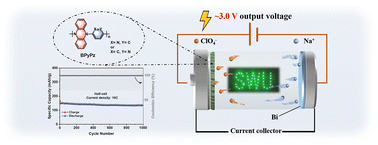A D–A type polymer as an organic cathode material for sodium-based dual-ion batteries with 3.0 V output voltage†
Abstract
Organic cathode materials for rechargeable metal-ion batteries have attracted much attention, while their applications are still limited by the unsatisfactory voltage platform owing to the low conductivity and high solubility of organic materials in the electrolyte. Rational molecular design is a promising way to solve the aforementioned problems. Dihydrophenazine (Pz) and its derivatives with high theoretical specific capacity and suitable oxidation–reduction potential are promising as ideal p-type cathode materials. Herein, the electron donating 5,10-dihydrophenazine is combined with the electron-withdrawing pyridine derivatives, and two donor–acceptor type polymers (BPyPz and TPyPz) are thus developed and successfully applied as p-type cathodes. The active site on Pz is affected by the position of the pyridine group, which significantly affects the redox potential and electrochemical properties of the materials. The structure–property relationship is investigated through density functional theory calculations and various electrochemical tests. BPyPz with pyridine connected to dihydrophenazine at the 2,5- position provides high reversible specific capacities of 205 mA h g−1 in a half-cell and 162 mA h g−1 in a full-cell, respectively. Notably, the average voltage of the full-cell is as high as 3.0 V, which is among one of the highest voltage platforms for organic cathodes in full-cells. Therefore, this work demonstrates the potential of sodium-based dual-ion full cells, and may provide guidance for the future design of high-voltage organic cathode materials.



 Please wait while we load your content...
Please wait while we load your content...